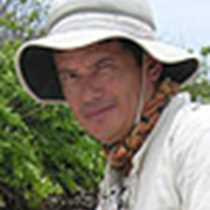Bartolomé and Santiago Islands
Santiago and Bartolomé Islands are located in the central part of the archipelago. It is thought that at one point in time the two islands were probably connected. With a rich human history, Santiago is an island with highlands and of course fresh water, but without inhabitants. Of course there were many attempts to colonize it in the past, but in 1960’s it was declared part of the Galápagos National Park. Its counterpart, Bartolomé is much smaller and dryer, but is one of the most visited because of its beautiful landscapes and geological formations.
Early in the morning, our guests landed at Bartolomé. Its appearance is as if an eruption suddenly stopped, leaving us the lava fields frozen in time. Down slope, we observed the hundreds of parasitic cones with their eroded craters and their incredible lava lizards who are able to survive in this barren environment. We started climbing up to the top, observing lava tubes, lifted light rocks and observing the huge black lava field on Santiago Island, a result of an eruption that occurred in 1897. Finally we arrived to the top of Bartolomé, and there we could see the archipelago in all its magnificence with a close up of the pinnacle rock.
After breakfast, we disembarked at Bartolomé again, but this time our guests had the opportunity to snorkel along the shore. The temperature was excellent and the water very clear. We observed black and white tipped reef sharks, many tropical fish and sea lions that played with us each time they appeared in front of us. Noon came upon us and we started sailing towards Santiago. The moment we were having lunch a group of bottle nose dolphins jumped happily around the National Geographic Islander. We circumnavigated enjoying them, watching how they jumped very close to us.
As soon as we arrived at Santiago, we started our activities with kayaking and snorkeling off the beach. With the weather conditions excellent, like in the morning, nobody remained onboard. From the kayaks we observed the island closer, checking a hidden face of Santiago, with many caves and cliffs along the shore and behind, the “pan de azucar” hill and an abandoned house showing us the last legacy of the humans here. At four o’clock we began the last activity, walking along the shore, our guests had the opportunity to see many species of migratory birds and sea lions; we walked on the rocks observing snails, crabs and chitons, a rare marine mollusk with a shell composed of eight overlapping plates. Finally, we arrived at the grottos, a place where there were many lava tubes, is the home of fur sea lions; much smaller than the Galápagos sea lion. The species was near extinction, caused by over hunting more than a hundred years ago, but they are now protected. We walked along the grottos observing the fur sea lions resting indifferently as we watched their bodies and their behavior, which is completely different, compared to the Galápagos sea lion. As it was late, after sunset and time to return onboard we arrived at the National Geographic Islander, enjoying a spectacular full moon over our heads. What a great day!!!
Call +1.800.397.3348 or contact your travel advisor


